|
|
|
Sort Order |
|
|
|
Items / Page
|
|
|
|
|
|
|
| Srl | Item |
| 1 |
ID:
126736
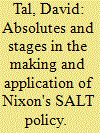

|
|
|
|
|
| Publication |
2013.
|
| Summary/Abstract |
President Richard Nixon and his National Security Adviser, Henry Kissinger took great pride in their success to achieve agreements on the limitation of Anti Ballistic Missiles and the Interim Agreement on Strategic Missiles with the Soviet Union. For Nixon, this agreement was not only an achievement that had been denied to his predecessor, it also seemingly represented the success of his own approach over that of his predecessors. Nixon-in tandem with Kissinger-intended to link arms control negotiations with the Soviet Union to the resolution of other political problems such as Vietnam, the Mideast, and Berlin. Through the employment of linkage, they hoped to make U.S. arms control policy part of Détente. However, Nixon was able to sign the "historic agreements" because his policy of linkage had in fact failed. It failed mainly because it was based on flawed assumptions and false premises. Thus, the historic success was possible precisely because Nixon had not actually made his arms control policy "distinct" from that of the Johnson Administration and its predecessors in his approach to strategic arms talks with the Soviet Union
|
|
|
|
|
|
|
|
|
|
|
|
|
|
|
|
| 2 |
ID:
130893
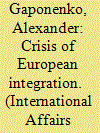

|
|
|
|
|
| Publication |
2014.
|
| Summary/Abstract |
AFTER THE USSR'S COLLAPSE, the Baltic states came under the political influence of the US and the economic influence of the European Union. This influence was used by their new geopolitical "curators" to initiate an anti-Russian line in both the foreign and domestic policies of Latvia, Lithuania and Estonia, as well as to break their economic ties with Russia. At present, the only significant economic ties that Russia still has with the Baltic countries are in the energy sector. It's the supply of natural gas through the pipeline and distribution systems with the use of the Incukalns underground storage facility. It's also the supply of Russian electricity and rail deliveries of hydrocarbons via the Ventspils and Klaipeda ports.
|
|
|
|
|
|
|
|
|
|
|
|
|
|
|
|
| 3 |
ID:
132444
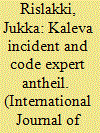

|
|
|
|
|
| Publication |
2014.
|
| Summary/Abstract |
An experienced U.S. code clerk was among the victims when the Soviets shot down a civilian Finnish passenger plane on a regular flight above the Baltic Sea in June 1940. It happened three months after the end of the Winter War between Soviet Union and Finland. Was the 27-year-old code expert Henry W. Antheil, and the diplomatic pouches and codes he was carrying, the reason for this attack?
Very belated, in May 2007, the name of Henry W. Antheil, Jr. was finally inscribed on a marble memorial plaque in the U.S. State Department's C Street lobby. 1 His career was cut tragically short on 14 June 1940, when his plane, the Finnish Aero airliner Junkers Ju 52 Kaleva was destroyed at 2:05 p.m. local time, shortly after taking off from Tallinn's Ülemiste airport en route to Helsinki.
|
|
|
|
|
|
|
|
|
|
|
|
|
|
|
|
| 4 |
ID:
130600
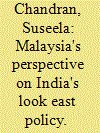

|
|
|
|
|
| Publication |
2014.
|
| Summary/Abstract |
The year 2012 completed 20 years of India's Look East Policy (LEP). Launched by former Indian Prime Minister P.V. NarashimeRao in 1992, this policy had its genesis in the end of the cold war following the collapse of the Soviet Union. To India, this policy was more than just a foreign policy alternative as it provided a development alternative as well, in synchronization with the globalization paradigm and the resurgence of Asia as an economic powerhouse. The 1990: saw a period rapid economic development and growth of Asian countries - especially Southeast Asia. With the abrupt collapse c the Soviet Union in 1991, India was left 'deprived' (the Soviet Union was lndia's strongest partner), and started to seek new markets t~
fuel its own economic growth. Thus Indian Prime Minister at the time P.V. Narasimha Rao, came up with the concept of a "Look East Policy for India. This was a policy of economic engagement with Southeast Asia and East Asia, to achieve two objectives. First was to encourage trade links with individual partners, and second, to provide foreign employment for India's own expanding work force (R.P. Khanna, 1991,6-7).
|
|
|
|
|
|
|
|
|
|
|
|
|
|
|
|
| 5 |
ID:
129105
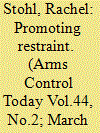

|
|
|
|
|
| Publication |
2014.
|
| Summary/Abstract |
On January 15, 2014, the United States released a document describing its new policy governing transfers of conventional weapons. The policy revision was long overdue, as the new publicly released document, Presidential Policy Directive 27 (PPD-27),[1] replaced a classified directive that came out in 1995.[2] The world has changed dramatically since the end of the Cold War. Until the release of the new policy document, however, the United States had been using policy guidance rooted in the geopolitical challenges created by the fall of the Soviet Union in making its arms transfer decisions and in outlining policy priorities and approaches to the global arms trade. According to a White House summary, a multi-year interval review of U.S. arms export policy "concluded that the 1995 conventional arms transfer policy was effective but needed to be updated to address 21st century national security and foreign policy objectives."[3] Thus, the new U.S. policy more accurately reflects the reality of U.S. arms transfers today. The Obama administration began its review when it came into office, but U.S. officials have said the impetus to finish the review came from events during the Arab Spring, when canisters of tear gas emblazoned with "Made in the USA" dominated pictures of the uprisings in Cairo's Tahrir Square. Questions surrounding U.S. arms sales to Egypt and other Arab countries led to increased scrutiny over the process of determining whether to transfer conventional arms and whether arms sales in fact led to U.S. influence over the recipient.
|
|
|
|
|
|
|
|
|
|
|
|
|
|
|
|
|
|
|
|
|